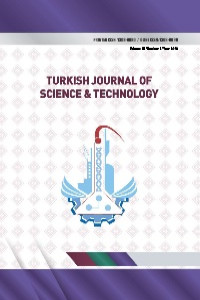Abstract
References
- Schmitz B, Holst C, Medic T, Lichti DD, Kuhlmann H. How to Efficiently Determine the Range Precision of 3D Terrestrial Laser Scanners. Sensors 2019; 19, 1466.
- Dumalski A. Evaluation of the possible application of terrestrial laser scanner-scanstation in vertical displacement measurements. Technical Sciences/University of Warmia and Mazury in Olsztyn, 2011; 33-43.
- Yıldız F, Altuntaş C. Yersel Lazer Tarayıcı Nokta Bulutlarının Jeodezik Koordinat Sistemine Dönüştürülmesi, Harita Dergisi 2009; Sayı:142.
- Yue D, Wang J, Zhou J, Chen X, Ren H. Monitoring slope deformation using a 3-D laser image scanning system: a case study. Min Sci Technol (China) 2010; 20(6), 898-903.
- El-Tokhey M, Abdel-Gawad AK, M Yasser, El-Maghraby AM. Accuracy assessment of laser scanner in measuring and monitoring deformations of structures 2012; 26. 144-151.
- Gonzalez H, Solla M, Armesto J, Arias P, Range, Close & Sensing, Remote & Group, Photogrammetry. Novel method to determine laser scanner accuracy for applications in civil engineering. Optica Applicata 2012; 42.
- Altuntaş C. Yersel Lazer Tarayıcı Nokta Bulutlarının Birleştirilmesi ve Jeodezik Koordinat Sistemine Dönüştürülmesi: Literatür Araştırması, Selçuk-Teknik Dergisi 2017; Cilt:16, Sayı:1-2017, Konya.
- Scaioni M, Forlani G. Independent model triangulations of terrestrial laser scanner data, In proc. of Vision Techniques for Digital Architectural and Archaeological Archives, Portonovo - Ancona , Italy, ISPRS Archives 2003; Vol.XXXIV-5/W12, 308-313.
- Elkharachy I, Neimeier W. Optimization and strength aspects for georeferencing data with terrestrial laser scanner systems, 3D IAG712th FIG symposium, Baden, Austria,2006; p.10 pages, May 22-24.
- Zeybek M. El-tipi LiDAR ölçme sistemleri ve 3B veri işleme. Türkiye Lidar Dergisi 2019; 1(1), 10-15.
The Effect of The Number of Reference Points and Distribution on Coordinate Transformation in Underground Mining Measurements
Abstract
This article focuses on examining the effect of the number and distribution of reference points on coordinate transformations in underground mining measurements using a handheld laser scanner. The points inside the mine were measured as reference using a Total Station. The same point cloud data was subjected to coordinate transformation with different numbers and elevations of reference points. It was observed that the homogeneous distribution of reference points used in the transformation increases precision in the horizontal and vertical directions. Both homogeneous and excessive use of transformation points result in the same good results in the horizontal, but in the vertical, it improves further. Using a large number of transformation points and using them at different elevations results in the same good results in the horizontal, but in the vertical, it increases precision even more. The article concludes that a sufficient number of homogeneously and heterogeneously distributed reference points are necessary for accurate coordinate transformation.
References
- Schmitz B, Holst C, Medic T, Lichti DD, Kuhlmann H. How to Efficiently Determine the Range Precision of 3D Terrestrial Laser Scanners. Sensors 2019; 19, 1466.
- Dumalski A. Evaluation of the possible application of terrestrial laser scanner-scanstation in vertical displacement measurements. Technical Sciences/University of Warmia and Mazury in Olsztyn, 2011; 33-43.
- Yıldız F, Altuntaş C. Yersel Lazer Tarayıcı Nokta Bulutlarının Jeodezik Koordinat Sistemine Dönüştürülmesi, Harita Dergisi 2009; Sayı:142.
- Yue D, Wang J, Zhou J, Chen X, Ren H. Monitoring slope deformation using a 3-D laser image scanning system: a case study. Min Sci Technol (China) 2010; 20(6), 898-903.
- El-Tokhey M, Abdel-Gawad AK, M Yasser, El-Maghraby AM. Accuracy assessment of laser scanner in measuring and monitoring deformations of structures 2012; 26. 144-151.
- Gonzalez H, Solla M, Armesto J, Arias P, Range, Close & Sensing, Remote & Group, Photogrammetry. Novel method to determine laser scanner accuracy for applications in civil engineering. Optica Applicata 2012; 42.
- Altuntaş C. Yersel Lazer Tarayıcı Nokta Bulutlarının Birleştirilmesi ve Jeodezik Koordinat Sistemine Dönüştürülmesi: Literatür Araştırması, Selçuk-Teknik Dergisi 2017; Cilt:16, Sayı:1-2017, Konya.
- Scaioni M, Forlani G. Independent model triangulations of terrestrial laser scanner data, In proc. of Vision Techniques for Digital Architectural and Archaeological Archives, Portonovo - Ancona , Italy, ISPRS Archives 2003; Vol.XXXIV-5/W12, 308-313.
- Elkharachy I, Neimeier W. Optimization and strength aspects for georeferencing data with terrestrial laser scanner systems, 3D IAG712th FIG symposium, Baden, Austria,2006; p.10 pages, May 22-24.
- Zeybek M. El-tipi LiDAR ölçme sistemleri ve 3B veri işleme. Türkiye Lidar Dergisi 2019; 1(1), 10-15.
Details
| Primary Language | English |
|---|---|
| Journal Section | TJST |
| Authors | |
| Publication Date | March 29, 2023 |
| Submission Date | January 24, 2023 |
| Published in Issue | Year 2023 Volume: 18 Issue: 1 |


